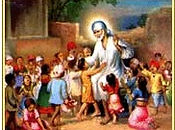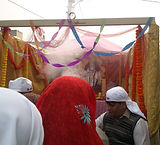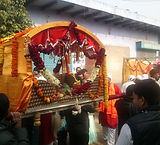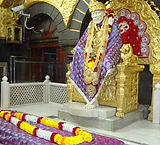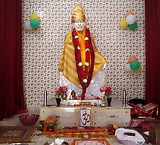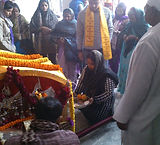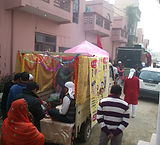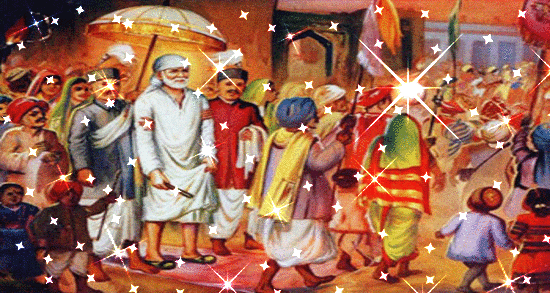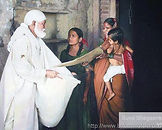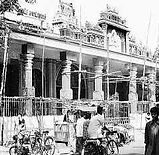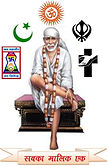Life of Shirdi Saibaba
Shri Saibaba of Shirdi lived between 1838 and 1918, whose real name, birthplace and date of birth are not known. An Indian spiritual guru and a fakir that transcended the barriers of religions, Saibaba of Shirdi was regarded with great reverence by both Hindu and Muslim followers. He lived in a mosque and after death his body was cremated in a temple.
His philosophy ingrained 'Shraddha' meaning faith and 'Saburi' meaning compassion. According to him Shraddha and Saburi were the supreme attributes to reach the state of godliness.
It is believed that at a tender age of 16 yrs Shri Saibaba arrived at the village of Shirdi in Ahmednagar district of Maharashtra and remained their till his death. He found shelter in Khandoba temple, where a villager Mahalsapathi in the temple addressed him as Sai or Saint.
Saibaba of Shirdi lived an extremely simple and austere life, sleeping on the floor of temple and later taking a ruined mosque as his shelter. With his arrival to Shirdi, in no time he began exhibiting a hypnotic attraction among people as they began flocking to him. He is attributed many miracles doing things that were beyond a mortal's power. He never discouraged these attributes and soon his fame spread like wild fire. Many pilgrims came seeking his blessings. Such was his hypnotism that even the mundane of his activities attracted large crowds.
Popular among both Hindus and Muslims, Shri Saibaba became a great building force between the two disparate communities. He regularly recited Hindu and Muslim prayers. His Hindu followers considered him to be an avatar or reincarnation of Shiva and Dattatreya. Sai Baba did not leave any written works. All his teachings were oral and catchy. His sayings were short, crisp and in layman language with which the common mass could easily associate.
Saibaba encouraged charity and said, "Unless there is some relationship or connection, nobody goes anywhere. If any men or creatures come to you, do not discourteously drive them away, but receive them well and treat them with due respect."
Shri Sai Baba of Shirdi was unique in the sense that he lived his message through the essence of his being. He lived among the common people adorning a torn kafni (long robe), sleeping over a mat while using brick as his headrest and got his food by begging. Such was his smile that radiated a mystical charisma and deep seated inward look that hypnotized the people who visited him.
His most concise message for one and all alike was "Why fear when I am here".
Saibaba said that he was a slave in the service of those who loved him. He was ever living to help those who turn to him and that he has to take care of his children day and night.
Saibaba's mission was to restore belief in god and according to him, "I give people what they want in the hope that they will begin to want what I want to give them (knowledge of the Ultimate)." He then taught values of total surrender to the Almighty Master (ALLAH MALIK EK- The only ONE) and experiences his grace.
Today, Shri Saibaba has millions of devotees in India and abroad. Shirdi, the obscure village in Maharashtra has become a pilgrimage destination much as Bethlehem, Jerusalem or Varanasi. With over 25,000 pilgrims thronging in here each day the number of pilgrims climb to over a hundred thousand on holidays and festival days. There are over 2,000 major Sai temples in different parts of India and 150 abroad in places as far-flung as Canada and Kenya, Singapore and England.
******************************************************************************
Sai Baba's Teachings
Sai Baba of Shirdi is the epitome of reverence a guiding force who generates supreme faith and confidence among his devotees looking for salvation and in quest of coming out of the drudgery of living. As a divine mother he is saturated with love for those who seek him. With his mission of making people about the divine consciousness and transcending the limits of mortal body, his teachings are guiding his devotees to the path of salvation. People are blessed who follow his teachings.
Among the teachings of Sai Baba of Shirdi there are the cardinal principles of Sai Path called 'Shraddha' and 'Saburi'. Sai Baba looks for these two qualities in his devotees. Here are the teachings and philosophies of Sai Baba of Shirdi.
Shraddha
'Shraddha' is a Sanskrit word, which roughly means faith with love and reverence. Such faith or trust is generated out of conviction, which may not be the result of any rational belief or intellectual wisdom, but a spiritual inspiration. According to Sai Baba of Shirdi, steadfast love in God is the gateway to eternity. Baba's teaching, both direct and indirect explicate the significance of 'Shraddha'. Baba reiterates the spiritual guidance of Shri Krishna to Arjun - "Whosoever offer to Me with love or devotion, a leaf, a flower, a fruit or water, that offering of pure love is readily accepted by Me".
Saburi
'Saburi'; means patience and perseverance. Saburi is a quality needed throughout the path to reach the goal. This quality must be ingrained in a seeker from day one, least he looses his stride and leaves the path half way
Purity
For Sai Baba it was not the purity of the body but inner purity that mattered. No amount of physical and external cleansing would serve any purpose if the man remained impure in mind and heart. Therefore, Baba cautioned His devotees not to make austerity as an end itself, lest they should indulge in physical mortification.
Compassion
Himself an epitome of compassion and love, Sai Baba taught compassion among his disciples. Baba often told His devotees, 'Never turn away anybody from your door, be it a human being or animal'.
Complete Surrender to the Guru
Sai Baba put Guru on a high pedestal of reverence. For Him Guru was the profound base of the path of devotion. Pointing to his physical frame, "This body is my house. I am not here. My Guru (Master) has taken me away". He asked for complete surrender to the 'Guru'.
Sai Baba's Teachings through 'Udi' and 'Dakshina'
Udi
Udi or the sacred ash was produced from the perpetual fire called 'dhuni' lit by Sai Baba in Dwarkamai at Shirdi. Explaining the meaning of life He would refer to Udi and taught that like Udi all the visible phenomena in the world are transient. Through this example Sai Baba wished to make his devotees understand the sense of discrimination between the unreal and the real. Udi taught the devotees discrimination or vivek.
Dakshina
Sai Baba would demand 'Dakshina' or alms from those who visited him. This explained the sense of non-attachment to worldly things. Hence Dakshina taught the devotees non-attachment or Vairagya.
*****************************************************************************
Festivals in Shirdi
Ramnavami : March/April
Guru Purnima : July
Shirdi Vijayadashmi (Sri Sai Punyatithi) October
Festivals are great time to visit Shirdi of Saibaba. There are three major festivals that are held in Shirdi attracting thousands of devotees from across the world. The three major festivals celebrated at Shirdi are Ramnavami, Guru Purnima and Shirdi Vijayadashmi. All these festivals are celebrated all across India with equal zest and excitement but at Shirdi they have some other significance. All these festivals have their special distinction to them in the way they are celebrated in the other parts of India. The distinction is the association of Saibaba himself which add to these festivals all new and exciting verve to them.
Ramnavami
Ramanavi is one of the most important festivals celebrated with great excitement and fanfare. In the year 1897 Goplarao Gund proposed holding in Urus in name of Saibaba in gratitude of a child which he was granted after so many childless years. Saibaba conceded to celebrate his urus on the condition that it be celebrated on Ramnavami. This was indeed an ingenious touch of Saibaba bringing together the Hindus and Muslims together. People may know Urus is a Muslim festival that is celebrated to honor a saint.
You can come to participate in Ramanavami at Shirdi, celebrated every year in March or April. This shows the kind of communal harmony that weaves people of different faiths at Shirdi. Ramnavami has equal and enthusiastic participation of both Hindus and Muslims. In Shirdi, two locally historic rituals are carried out during this festival. The sack of wheat that is kept in Dwarkamai is changed and the old one taken to prasadalaya to be used there, and secondly, the dwarkamai flags are replaced. This year that is in 2007, Shirdi is celebrating the Ramnavami from 26th to 28th of March.
Gurupurnima
Gurupurnima or Full Moon is also a wonderful time to visit Shirdi. It is the time to honor the Guru and seek his special blessing. Quite a significant festival in Shirdi Guru Purnima was the only festival which Saibaba has asked his devotees to celebrate. This is the time devotees all across the world converge in Shirdi to seek Saibaba's blessings. There is also Vyasa Puja that is held during Guru Purnima, in honor of Ved Vyasa who wrote the epic Mahabharata.
Shirdi Vijayadashmi
Vijayadashmi is a big festival in Shirdi, venerated as a holy day when Shri Saibaba left his mortal body for heavenly abode. The festival is also celebrated as Shri Sai Punyathithi in Shirdi attracting great number of devotees from all over the world. Various religious activities are arranged Great number of people flock to Shirdi during this Festival. During this festival 'Brahman Bhojan' is arranged with Dakashina (Donation to Guru). This year the festival is celebrated from 20th to 23rd October.
JAI SAI RAM
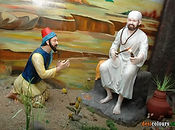


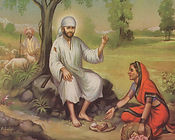
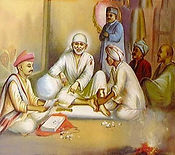
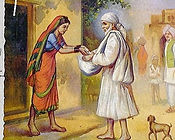
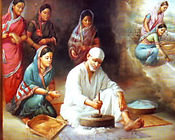


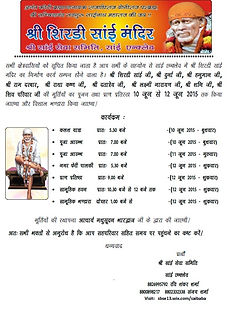
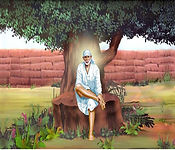
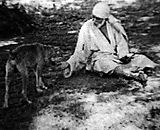


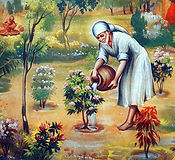


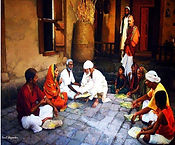
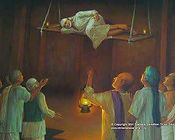
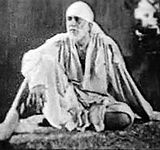
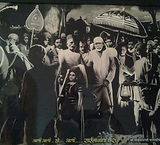


Shree Sai Baba History
